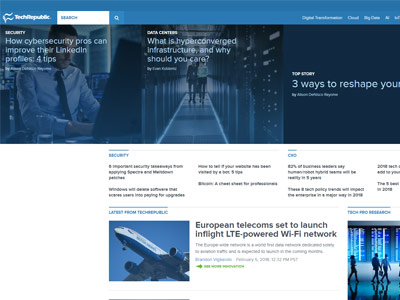Discover the Best tech blog for the current Trends and Developments in Innovation
Discover the Best tech blog for the current Trends and Developments in Innovation
Blog Article
Recognizing the Surge of Edge Computer in Today's Digital Globe
In the rapidly developing landscape of modern technology, edge computing arises as a crucial pressure, reshaping how data is refined and made use of. This paradigm change is driven by the spreading of IoT devices and an intensifying need for rapid data processing. By transitioning information monitoring closer to the resource, side computing addresses critical latency problems while optimizing bandwidth usage and improving safety and security measures. As sectors pivot in the direction of smarter, more effective systems, understanding the nuances and ramifications of this technical improvement comes to be essential. What does this mean for future innovations and the digital community all at once?
What Is Edge Computing
Side computer, although a relatively current advancement in the world of innovation, essentially changes how information is processed and handled by bringing calculation and information storage closer to the place where it is needed. Unlike typical cloud computer models, which often count on centralized data facilities that can be geographically remote, side computer decentralizes data handling. This distance minimizes latency, enhances real-time data handling, and boosts the general customer experience by ensuring quicker feedback times.
At its core, edge computing entails a network of localized gadgets and facilities, such as gateways, routers, and sensors, with the ability of processing information at or near the source. This localized processing capacity is specifically critical for applications needing instant information evaluation, such as autonomous cars, commercial automation, and wise cities. In addition, by offloading information handling jobs from main web servers, edge computing reduces data transfer demands and improves data privacy and protection, as delicate information can continue to be on-site as opposed to passing through extensive networks.

Key Drivers of Fostering
Numerous variables are moving the adoption of side computing in today's digital landscape. Side computing addresses this need by making it possible for data processing closer to the information source, lowering latency and enhancing real-time decision-making capacities.
One more significant motorist is the demand for boosted transmission capacity performance. Central cloud systems can end up being overwhelmed with the sheer quantity of data produced by IoT tools, leading to traffic jams (Best tech blog). By refining data at the edge, companies can alleviate network blockage and improve general system efficiency
In addition, security and personal privacy concerns are pressing companies toward side computing. By processing delicate data locally, business can reduce threats connected with data transmission and direct exposure to potential cyber risks.
The rise of applications needing real-time processing, such as independent cars and augmented fact, also requires the quick response times that edge calculating offers. Collectively, these chauffeurs are making edge computing an indispensable part of modern-day IT framework, leading the way for its prevalent fostering across numerous markets.
Advantages Over Cloud Computer
How does edge computer distinguish itself from traditional cloud computing? Primarily, edge computer brings data handling closer to the source of data generation, often on nearby web servers or regional tools, instead than counting on central information. This proximity substantially lowers latency, allowing real-time information handling and decision-making. For industries where official source milliseconds issue, such as independent lorries or industrial automation, the decreased latency given by side computing can be critical.
Moreover, side computer improves bandwidth performance (Best tech blog). By refining data in your area, just the necessary information is transmitted to the cloud for more analysis or storage space, reducing the volume of data that passes through the network. This not only eases network blockage however likewise lowers data transmission prices
Edge computing likewise offers better data privacy and protection. Sensitive information can be processed locally without being sent to the cloud, lessening the exposure to prospective cyber threats. This is particularly valuable for industries dealing with secret information, such as healthcare and monetary solutions.
Moreover, edge computer makes sure greater durability and integrity. Neighborhood processing permits proceeded operation also when connection to the cloud view it now is jeopardized, preserving crucial functions and solutions despite potential network disruptions. These advantages collectively demonstrate edge computer's transformative possibility in maximizing performance and security in electronic communities.
Factors To Consider and obstacles
While side computer offers numerous advantages, it also offers special obstacles and considerations that must be resolved to completely understand its capacity. Furthermore, managing and checking a decentralized network of side tools can be intricate, needing innovative tools and techniques to guarantee seamless procedure and upkeep. Best tech blog.
One more consideration is the scalability of side computer remedies. As the number of connected devices grows, so does the demand for refining power at the edge, which can bring about resource constraints. Organizations must meticulously plan their framework to suit this development without jeopardizing performance or efficiency.
Interoperability is an additional crucial factor. With different software and hardware elements entailed, making certain compatibility and smooth combination can be challenging. Standardization efforts are important to assist in interaction between diverse systems.
Future Patterns in Edge Computing
Expecting the future, edge computer is positioned to change different industries by allowing much faster information handling and reducing latency. As the volume of information created by IoT tools proceeds to expand, side computing will become significantly essential in handling this influx efficiently.
One more arising fad is the growth of edge-native applications developed particularly to leverage the unique capabilities of side computing. These applications will certainly maximize efficiency and source application, causing increased effectiveness across various sectors. Furthermore, developments in 5G innovation will certainly additionally boost side computer by offering the essential framework for high-speed, low-latency interaction in between devices and edge nodes.
Conclusion
Edge computer's increase is driven by the proliferation of IoT tools and the demand for real-time data handling, which boosts effectiveness by reducing latency and decentralizing explanation data administration. This method minimizes data transfer inefficiencies and safety and security concerns, helping with improvements in applications like clever cities and autonomous lorries. Regardless of obstacles such as facilities intricacy and assimilation, the future of side computer guarantees a more receptive electronic ecosystem, with continued technologies shaping its advancement and broadening its applicability throughout industries.
Side computing, although a reasonably recent improvement in the world of modern technology, essentially changes how data is refined and handled by bringing calculation and information storage closer to the location where it is needed. Unlike standard cloud computer models, which usually rely on centralized data centers that can be geographically far-off, side computer decentralizes data handling. Furthermore, by unloading information handling jobs from central servers, edge computing minimizes transmission capacity needs and enhances data personal privacy and protection, as delicate info can continue to be on-site rather than going across comprehensive networks.

Report this page